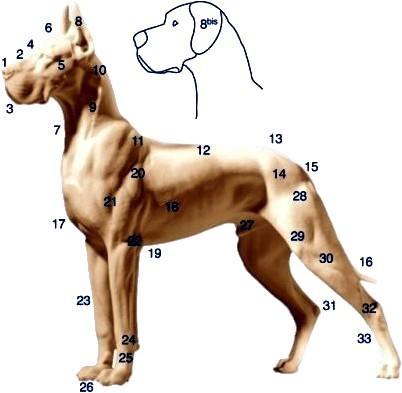The english standard for the great dane
Origin
United-Kingdom, The Kennel Club
Effective date of the standard
October 2006.
General appearance
Very muscular, strongly though elegantly built, with look of dash and daring, of being ready to go anywhere and do anything. Head and neck carried high, tail in line with back, or slightly upwards, but never curled over hindquarters. Elegance of outline and grace of form most essential.
Characteristics
Alert expression, powerful, majestic action displaying dignity.
Temperament
Kindly without nervousness, friendly and outgoing.
Terms used in the great dane standard

| 1. Nose | 12. Back and Loin | 23. Forearm |
| 2. Nasal-bridge | 13. Croup | 24. Carpal joint |
| 3. Lips | 14. Pelvis | 25. Pastern |
| 4. Stop | 15. Set of the tail | 26. Toes |
| 5. Cheeks | 16. Tail | 27. Penis |
| 6. Skull | 17. Forechest | 28. Upper thigh |
| 7. Throat | 18. Ribcage | 29. Patella |
| 8. Ears | 19. Breastbone | 30. Lower thigh |
| 9. Neck | 20. Shoulder blade | 31. Point of the hock |
| 10. Nape | 21. Upper arm | 32. Hock |
| 11. Withers | 22. Elbow | 33. Rear Pastern |
Head and Skull
Head, taken altogether, gives idea of great length and strength of jaw. Muzzle broad, skull proportionately narrow, so that whole head when viewed from above and in front, has appearance of equal breadth throughout. Length of head in proportion to height of dog. Length from nose to point between eyes about equal or preferably of greater length than from this point to back of occiput. Skull flat, slight indentation running up centre, occipital peak not prominent. Decided rise or brow over the eyes but not abrupt stop between them; face well chiselled, well filled in below eyes with no appearance of being pinched: foreface long, of equal depth throughout. Cheeks showing as little lumpiness as possible, compatible with strength. Underline of head, viewed in profile, runs almost in a straight line from corner of lip to corner of jawbone, allowing for fold of lip, but with no loose skin hanging down. Bridge of nose very wide, with slight ridge where cartilage joins bone (this is a characteristic of breed). Nostrils large, wide and open, giving blunt look to nose. Lips hang squarely in front, forming right angle with upper line of foreface.
Eyes
Fairly deep set, not giving the appearance of being round, of medium size and preferably dark. Wall, or odd eyes permissible in harlequins.
Ears
Triangular, medium size, set high on skull and folded forward, not pendulous.
Mouth
Teeth level. Jaws strong with a perfect, regular and complete scissor bite, i.e. upper teeth closely overlapping lower teeth and set square to the jaws.
Neck
Neck long, well arched, quite clean and free from loose skin, held well up, well set in shoulders, junction of head and neck well defined.
Forequarters
Shoulders muscular, not loaded, well sloped back, with elbows well under body. Forelegs perfectly straight with big flat bone.
Body
Very deep, brisket reaching elbow, ribs well sprung, belly well drawn up. Back and loins strong, latter slightly arched.
Hindquarters
Extremely muscular, giving strength and galloping power. Second thigh long and well developed, good turn of stifle, hocks set low, turning neither in nor out.
Feet
Cat-like, turning neither in nor out. Toes well arched and close, nails strong and curved. Nails preferably dark in all coat colours, except harlequins, where light are permissible.
Tail
Thick at the root, tapering towards end, reaching to or just below hocks. Carried in straight line level with back, when dog is moving, slightly curved towards end, but never curling or carried over back.
Gait/Movement
Action lithe, springy and free, covering ground well. Hocks move freely with driving action, head carried high.
Coat
Short dense and sleek-looking, never inclined to roughness.
Colour
- Brindles : must be striped, ground colour from lightest buff to deepest orange, stripes always black, eyes and nails preferably dark, dark shadings on head and ears acceptable.
- Fawns : colour varies from lightest buff to deepest orange, dark shadings on head and ears acceptable, eyes and nails preferably dark.
- Blues : colour varies from light grey to deep slate, the nose and eyes may be blue.
- Blacks : Black is black.
- Mantle : Black and white with a solid, black blanket extending over the body. Ideally - black skull with white muzzle, white blaze optional, whole white collar preferred, a white chest, white on part or whole of the forelegs and hindlegs, white tipped black tail. Nose always black, eyes and nails perfectly dark.
- Harlequins : pure white underground with preferably all black patches or all blue patches, having appearance of being torn. Light nails permissible. In harlequins, wall eyes, pink noses, or butterfly noses permissible but not desirable.
In brindle, fawn, blue and black colours white is only permissible on chest and feet, but it is not desirable even there. Nose always black, except in blues and harlequins. Eyes and nails perfectly dark.
Size
Minimum height of an adult dog over eighteen months: 76 cms (30 ins); bitches: 71 cms (28 ins). Weight, minimum weight over eighteen months: dogs: 54 kgs (120 lbs); bitches: 46 kgs (100 lbs).
Faults
Any departure from the foregoing points should be considered a fault and the seriousness with which the fault should be regarded should be in exact proportion to its degree and its effect upon the health and welfare of the dog.
Note
Male animals should have two apparently normal testicles fully descended into the scrotum.
Top of the page

